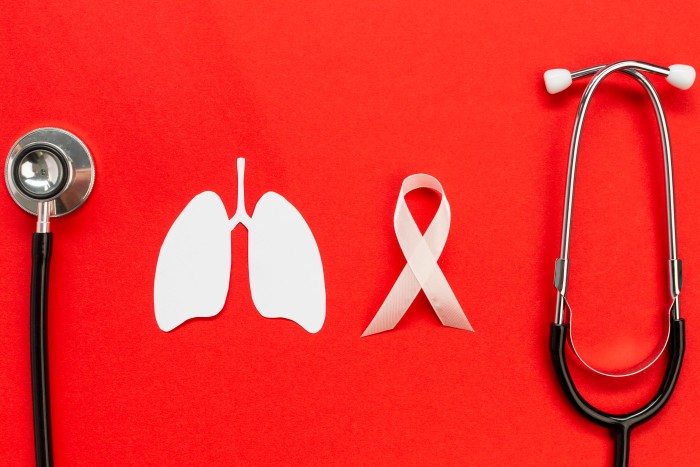IMANA NEWS
What You Should Know This World Lung Cancer Day
08 July 2025
 This August 1, the global medical community observed the 13th World Lung Cancer Day. Organizations, nonprofits, and individuals from across continents came together to raise awareness about the prevention and detection of the deadly illness.
This August 1, the global medical community observed the 13th World Lung Cancer Day. Organizations, nonprofits, and individuals from across continents came together to raise awareness about the prevention and detection of the deadly illness.
It’s a movement we need now more than ever. The American Cancer Society estimates that 200,000 Americans will be diagnosed with lung cancer in 2025. It’s one of the most common forms of cancer, appearing only a little less frequently than some skin and breast cancers. But it’s by far the most deadly, especially when detected late.
At the Islamic Medical Association of North America (IMANA), we believe that staying proactive and aware is the best way to avoid contracting serious illnesses. This article will highlight what you need to know on World Lung Cancer Day 2025.
What Causes Lung Cancer?
A lung cancer day was first established in 2012 by the Forum of International Respiratory Societies. The body, along with other health organizations, highlighted multiple causes for concern. This includes:
Tobacco Smoke
Tobacco smokers are at the highest risk of contracting lung cancer. They account for up to 80% of all patients. This includes cigarette smokers, as well as those who smoke cigars, hookahs, or are frequently exposed to second-hand smoke.
The United States has made several positive strides in this regard. The number of adult long-term smokers has declined by 73% from 1965 to 2022. The number of young people taking up smoking, meanwhile, was as low as 3.8% in 2021.
The numbers are certainly headed in a comforting direction. But with that said, studies are still being conducted on the impact of two new trends in smoking: marijuana and e-cigarettes (or vapes).
Radon Exposure
The Environmental Protection Agency says exposure to radon is the second biggest cause of lung cancer in the U.S. — and the leading cause among non-smokers.
This highly-carcinogenic gas is found mostly in rocks, soil, and water. From there, it has a tendency to seep into homes through cracks. The EPA says these leaks are associated with 21,000 cases of lung cancer a year — 2,900 of which occur in non-smokers.
Asbestos is another known carcinogen with similar effects, although its use has been largely phased out. Radon, by contrast, is harder to avoid, and requires homeowners to carefully plug all gaps, and conduct frequent tests of their home’s air quality.
Air Pollution
Another factor that’s hard to avoid is pollution. Fortunately the risk of non-smokers contracting lung cancer from air pollution is low. However, it’s been found that smaller pollutants can potentially enter the lungs and can pose a risk.
In the U.S., air quality has improved significantly. But globally, it’s seen some drastic declines. In 2013, an 8-year-old girl in China was diagnosed with lung cancer. Her doctors say it was because of the high PPM levels in the Jiangsu province air — marking what could be the first official case of pollution-triggered lung cancer.
What is the Life Expectancy of Lung Cancer Patients?
It’s hard to provide an exact timeline when dealing with a life threatening illness.
Cancer life expectancy is, instead, better understood through a five-year survival rate. This is the likelihood that a patient survives five years from the point of diagnosis.
In 2020, it was found that the average five-year survival rate was 26.6%. This was a significant improvement compared to any time in the past — but still very low. The factors that affect survival rates include:
- Detection Stage: Lung cancer is hard to detect in its early stages and hard to treat in its later stages.
- Age: Lung cancer is uncommon among people younger than 40 — the average age of diagnosis is 70, when five-year survival rates are already lower.
- Sex: In a majority of cases, women have more positive prognosis when compared to men. This trend is seen across the disease lifecycle.
- Type: There are a few different types of lung cancers. Rarer deadlier forms as well as forms that are easier to treat.
- Environment and background: People from certain ethnic or geographic backgrounds have lower survival rates on average — mainly due to disparities in healthcare delivery or income.
All these factors and more influence the survival rate post diagnoses. At the end of the day, the best course of action is to quit — or never take up — smoking. But beyond that, look out for risk factors and get yourself screened accordingly.
Who Should Get Screened
Frequent lung cancer screenings aren’t generally recommended for healthy, young individuals. Lung cancer does affect thousands of non-smokers every year but is overwhelmingly more likely to appear in those who do smoke.
This year, we recommend getting screened if you:
- Have a 20-pack year smoking history. (Smoking a pack a day for 20 years, or two packs a day for 10 years, and so on.)
- Are above 50 years old
- Currently smoke, or have quit within the last 15 years
- Have a history of alcohol abuse
- Suffer from obesity
- Suffer from a chronic viral infection
Screenings are crucial because early detection is the best prevention. The survival rate jumps drastically for patients who find the cancer in its first stage.
Support Our Mission
At IMANA we dream of a world free from all forms of cancer. As a body that works tirelessly to deliver emergency medical relief in underrepresented regions across the world, we understand how devastating the disease can be.
That’s why we’re building a world with better outcomes, faster diagnoses, and more resilience. Support us with a small donation if you have the means. But even if not, simply sharing this article can help us raise awareness.